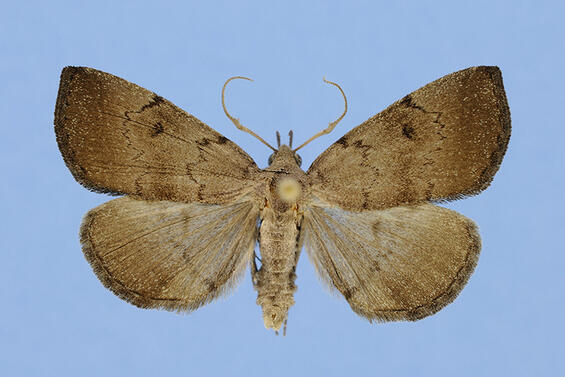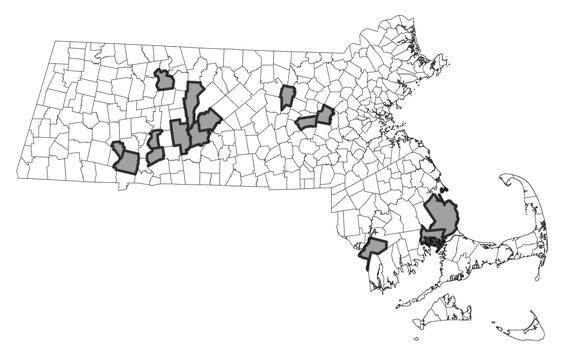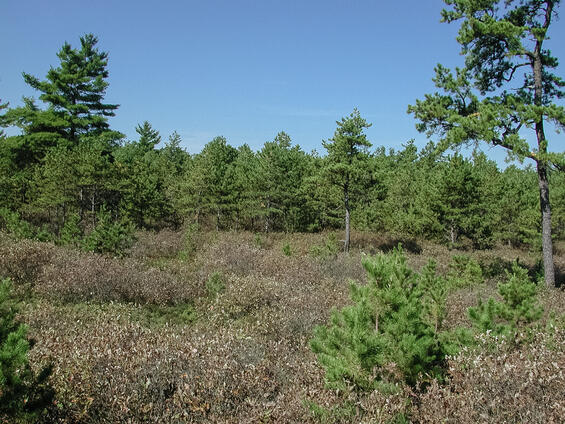- Scientific name: Zanclognatha martha
- Species of Greatest Conservation Need (MA State Wildlife Action Plan)
- Special Concern (MA Endangered Species Act)
Description

Pine barrens zanclognatha, Zanclognatha martha
The pine barrens zanclognatha (Zanclognatha martha) is an erebid moth with a wingspan of 25-30 mm (1.0-1.2 in) (Forbes 1954). The forewing is dark brown, paler proximally (in the basal area) and darker distally (in the terminal area); the postmedial and antemedial lines are very dark brown, almost black, jagged and narrow, but wider toward the costal margin. The reniform spot is a small dot, concolorous with the postmedial and antemedial lines. The hind wing is brown, paler than the forewing on average, but darker towards the outer margin; a darker brown, but faint postmedial line and discal spot are present. The head and thorax are concolorous with the proximal portion of the forewing, and the abdomen is concolorous with the hind wing. Subterminal lines of the forewing and hind wing, when present, are faint and considerably obscured as compared to the similar conifer zanclognatha (Zanclognatha protumnusalis).
Life cycle and behavior
In Massachusetts, the pine barrens zanclognatha flies in July and early August. Larvae feed on pitch pine (Pinus rigida) (Wagner et al. 2011). Larvae overwinter partially grown, resume feeding in spring, and pupate by June.

Distribution and abundance
The pine barrens zanclognatha is spottily distributed from Maine south to Florida, and west to Wisconsin and Texas (Wagner et al. 2011). In Massachusetts, it occurs in barrens habitats from the Connecticut River Valley east to Plymouth but is absent from Cape Cod and the offshore islands.

Distribution in Massachusetts.
1999-2024
Based on records in the Natural Heritage Database.
Habitat
The pine barrens zanclognatha inhabits pitch pine-scrub oak barrens on sandplains or rocky summits and ridges, including late-successional barrens.
Healthy habitats are vital for supporting native wildlife and plants. Explore habitats and learn about conservation and restoration in Massachusetts.

Pitch pine-scrub oak barrens habitat for the pine barrens zanclognatha. Habitat managed by MassWildlife at Southeast Pine Barrens Wildlife Management Area.
Threats
The pine barrens zanclognatha is threatened by habitat loss and fire suppression in its disturbance-dependent habitats, in particular pitch pine-scrub oak barrens. Other potential threats include introduced generalist parasitoids and aerial insecticide spraying. The effect of a warming climate may not be detrimental to this species in Massachusetts; its range extends south to Florida, suggesting adaptation to warm temperatures.
Conservation
Land protection and habitat management are the primary conservation needs of this species in Massachusetts. In particular, pitch pine-scrub oak barrens should be conserved, restored, and managed to maintain habitat for this species and the entire suite of rare and threatened species dependent on such habitat.
Survey and monitoring
The distribution of the pine barrens zanclognatha in pitch pine-scrub oak barrens is well documented. However, ridgetop pitch pine-scrub oak barrens in the western part of the state are likely under surveyed for this species. Known populations of this species should be surveyed to document persistence at least once every 25 years; every 10 years is more desirable when practicable.
Management
Management of sandplain and ridgetop pitch pine-scrub oak barrens benefits a suite of rare and threatened species, and habitat condition should be monitored and management adapted as needed.
Research needs
The natural history and conservation needs of the pine barrens zanclognatha are relatively well known. However, the future effects of a warming climate on this species are unpredictable and should be documented.
References
Forbes, W.T.M. 1954. Lepidoptera of New York and Neighboring States. Part III. Memoir 329, Cornell University Agricultural Experiment Station, Ithaca, New York. 433 pp.
Wagner, D.L., D.F. Schweitzer, J.B. Sullivan, and R.C. Reardon. 2011. Owlet Caterpillars of Eastern North America. Princeton University Press, Princeton, New Jersey. 576 pp.
Contact
| Date published: | March 21, 2025 |
|---|